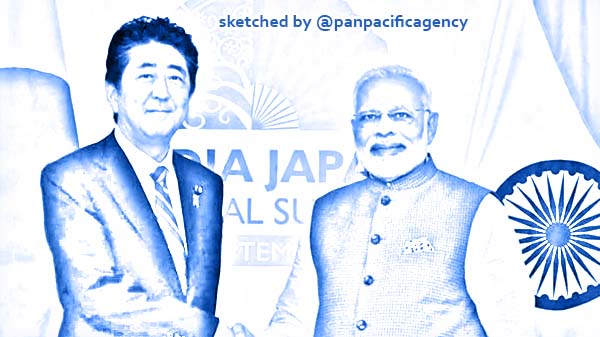[Analytics] India’s Northeast is the gateway to greater Indo-Pacific engagement

Japanese PM Shinzo Abe was expected to meet PM Modi in Guwahati on Sunday. Sketched by the Pan Pacific Agency.
India’s Northeastern states — a strategic plank situated between Delhi and Southeast Asia over the Bay of Bengal — anchor the convergence of Japan’s Free and Open Indo-Pacific (FOIP) vision and India’s Act East policy. Bordering China and Bhutan to the north and Bangladesh and Myanmar to the west and east, Northeast is a key frontier in India’s Indo-Pacific engagement. Titli Basu specially for the East Asia Forum.
Given the Northeast’s strategic value, Modi has invested political capital into reorienting the narrative of the ‘tyranny of distance’ to mainstreaming the Northeast in India’s eastward outreach.
But developing a Northeast industrial corridor to facilitate greater connectivity through regional value chains and production networks requires significant infrastructure investment. In this pursuit, India is nurturing win–win cooperation with Japan as Prime Minister Shinzo Abe promotes high quality infrastructure and facilitates Japan’s expansion into emerging Asian markets to boost productivity.
With the establishment of the India–Japan Act East Forum in 2017, investing in economic modernisation projects in the Northeast became a strategic priority in India–Japan relations. For India, acting east requires Japan’s help in developing robust regional economic and connectivity corridors, especially through Bangladesh and Myanmar. Tokyo perceives Northeast India as a critical geostrategic space in implementing the FOIP and understands the need to connect to the Bay of Bengal by promoting infrastructure projects in the broader Indo-Pacific region.
For Tokyo, infrastructure financing targets two objectives: creating a new growth engine to support the Japanese economy by capturing the global infrastructure market and reinforcing strategic partnerships to balance the emergence of a China-centric order. Infrastructure has emerged as an important geo-economic instrument of statecraft among great powers. South and Southeast Asia have become key theatres for strategic competition between Japan and China.
Infrastructure financing is a key component of the Japan’s Economic Revitalization Strategy and Development Cooperation Charter. Japan backs high quality infrastructure through its Expanded Partnership for Quality Infrastructure (EPQI) initiative. Given India’s economic outlook, growing market and rising strategic importance, Tokyo recognises the value of investing in India. Tokyo is pushing the EPQI as a win–win formulation since it intersects with Modi’s Make in India initiative and is amenable to high-risk projects.
Japan’s footprint in Northeast India’s infrastructure is ever expanding, including through the North East Road Network Connectivity Improvement Project. Development assistance from Japan is being used to improve roads such as the NH-54 (Aizawl to Tuipang) in Mizoram, that would advance Kaladan Multi Modal Transport Corridor connectivity; the NH-51 (Tura to Dalu) in Meghalaya that connects to Bangladesh border; the NH-40 (Shillong to Dawki) in Meghalaya; the Dhubri/Phulbari Bridge across the Brahmaputra River; and the Gelephu–Dalu Corridor in collaboration with the Asian Development Bank (ADB).
As Tokyo and Delhi discuss advancing infrastructure in Northeast India, it will be pragmatic to build synergy with complementary ADB projects. This infrastructure will then link Northeast India to emerging Southeast Asian markets via the India–Myanmar–Thailand Trilateral Highway, the Kaladan Multi-Modal Transit Transport Project, the Asian Highway Network and the South Asia Subregional Economic Cooperation Road Connectivity Investment Program.
The Trilateral Highway, which is aligned with Asian Highway, if extended to Vietnam through Cambodia and Laos, it will help India deepen its economic engagement with Southeast Asia.
Japan’s horizontal connectivity projects in the region — the East–West Economic Corridor and the Southern Economic Corridor — could benefit India. For the former, resources from the ADB, Japan International Cooperation Agency (JICA) and Japan Bank for International Cooperation (JBIC) were used. This type of smart and effective cooperation can be tried out in India as it builds transport and economic corridors.
India has emerged as one of Japan’s largest development partners. In the last decade, 64 per cent of Japan’s Official Development Assistance (ODA) loans have been directed to the transportation sector. The ADB primarily focusses on India’s transportation and energy sectors and the ADB’s Country Operations Business Plan 2018–2020 specifies that around 84 per cent of the proposed program will support inclusive access to infrastructure and services. As the transportation sector is accorded importance by both JICA and ADB, forming synergy will help realise the objective of connecting India to South and Southeast Asian markets.
Augmenting Northeast India’s connectivity through Bangladesh and Myanmar is vitally important for India. Cooperating with Japan will reinforce international standards of openness, transparency, economic viability and financial sustainability for these cross-border projects. But the success of any collaborative effort will be contingent on how their different approaches in terms of professional culture are synergised while operationalising projects.
India is an important pillar of Japan’s Indo-Pacific vision. It is therefore in Tokyo’s interests to back an economically confident and resilient India to drive growth and prosperity in the Indo-Pacific. Japan is in a strong position not only to employ its infrastructure financing policy through its ODA and the EPQI initiative but also align it through its influence among the multilateral development banks — especially the ADB — to help India realise its growth potential.
Titli Basu is Associate Fellow with the East Asia Centre at the Institute for Defence Studies and Analyses (IDSA), New Delhi.